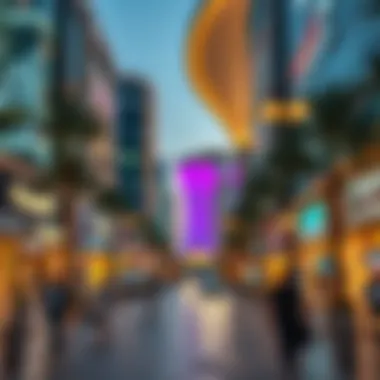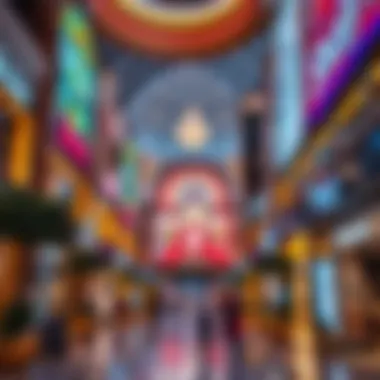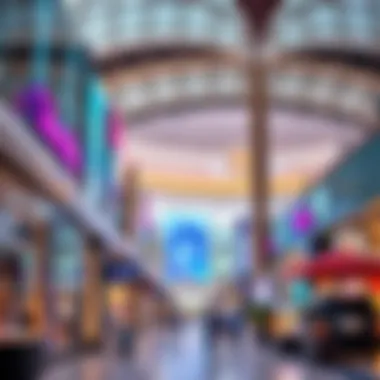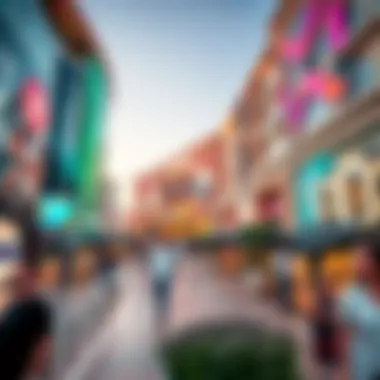Discovering Shopping Gems in Dubai's Festival City


Intro
Festival City in Dubai presents an enticing retail landscape that goes beyond mere shopping. It’s a place where consumer desires meet cultural vibrancy and innovation. As Dubai continues to solidify its place as a global shopping hub, Festival City stands out with its unique mixture of commerce, community, and celebration. From luxury boutiques to local artisanal shops, the area offers something for everyone—from the discerning shopper seeking high-end brands to families looking for casual and diverse shopping experiences.
In exploring the shopping destinations within Festival City, we will examine the wide range of retail offerings, the importance of cultural festivities in shaping the shopping experience, and how both locals and international visitors can enjoy the rich tapestry of commerce this vibrant area provides.
Here, we’ll delve into the intricacies of the market, analyze current trends, and forecast future projections that guide investors, realtors, and developers in making informed decisions. With a keen understanding of the evolving market dynamics, those interested can leverage opportunities in one of the global trading hotspots. Thus begins our examination of this remarkable district in the heart of Dubai.
Prolusion to Festival City
Festival City stands out as a remarkable destination within Dubai, offering a shopping experience that’s as diverse as its visitor base. This district elegantly merges modern retailing with traditional values, creating a shopping environment that caters not just to needs, but to the aspirations of its patrons. Understanding Festival City is essential for anyone who has an interest in Dubai's economic landscape, whether you are a savvy investor or a curious traveler. The area is rich in opportunities and showcases the remarkable strides Dubai has made in creating a hub for commerce and culture.
Overview of the District
Festival City is more than just a shopping area; it is a vibrant microcosm of the eclectic blend of cultures that Dubai proudly displays. Covering a vast area on the banks of Dubai Creek, the district boasts shopping centers, residential properties, and even leisure facilities. Here, malls like the Festival City Mall host an array of international brands alongside local boutiques.
The layout of the district encourages foot traffic, making it easy for visitors to navigate through its shops, restaurants, and entertainment venues. Defined pathways and inviting public spaces promote both relaxation and exploration, allowing shoppers to immerse themselves fully in their experience, rather than just darting through stores.
With its waterfront views, lush parks, and thriving markets, Festival City is a destination designed for both residents and tourists alike, seamlessly combining a shopping spree with leisurely afternoons by the creek. This unique blend not only enhances the attractiveness of the district but also underscores the thoughtful planning invested into its development.
Historical Context
The inception of Festival City dates back to the late 1990s, when the vision was brought forth by the Al-Futtaim Group. Originally conceived as a development that would cater to Dubai’s growing population and its burgeoning tourism sector, it has since evolved into a cornerstone of the city’s retail environment.
The establishment of the center was part of a larger effort to transform Dubai into a global business and tourism hub. This vision has certainly borne fruit; the district has continually adapted to emerging trends, evolving past its initial offerings to become a dynamic shopping destination. As Dubai expanded, so did Festival City, aptly reflecting the city’s commitment to growth and innovation.
Through strategic planning and dedication to quality, Festival City has garnered attention not just locally but on an international scale. This evolution has made it synonymous with high-quality retail experiences and has positioned it as a significant player in the global retail market.
"Festival City embodies the spirit of Dubai, where tradition meets modern commerce on a vibrant canvas."
The Unique Retail Environment
The retail setting in Festival City is not just about shopping; it's a reflection of a lifestyle, blending commerce with culture in a unique tapestry. This area boasts an environment that attracts both the local populace and international tourists, creating a vibrant fusion of tastes and preferences. Understanding this landscape is essential as it highlights the myriad choices available for every shopper, from high fashion to artisanal crafts.
Design and Layout
The layout of Festival City has been crafted with shopper convenience in mind. The expansive spaces are designed to provide a flow that encourages exploration. Wide walkways, ample seating areas, and cleverly positioned signage not only guide the foot traffic but also enhance the shopping experience. Shoppers often find themselves wandering from one boutique to the next without feeling cramped or hurried. This design philosophy encourages leisurely browsing, promoting the idea that shopping should be an experience rather than a chore.
Moreover, the integration of green spaces throughout the shopping district brings a breath of fresh air. These areas serve as rest stops where visitors can appreciate the environment while enjoying their purchases. The thoughtful placement of cafes and eateries among the shops ensures that breaks can be easily taken, turning shopping into an all-day affair.
Architectural Highlights
The architectural features of Festival City are nothing short of impressive. The structures reflect a contemporary aesthetic while paying homage to traditional Emirati design principles. For instance, the use of glass and steel in modern facades contrasts beautifully against intricate stone carvings reminiscent of the region's heritage. This juxtaposition not only captures the eye but also tells a story of a city balancing its rich history with future aspirations.
Notably, the Dubai Festival City Mall stands out with its iconic elements, such as the Festival Bay waterfront, which features a multi-sensory light and water show, captivating shoppers as they engage in retail therapy. Visitors can marvel at how the architecture aligns with the overall shopping experience, making it more than just a collection of stores—it’s a destination.
Overall, the unique retail environment of Festival City is characterized by a deliberate design and standout architecture that work in harmony. These elements contribute significantly to a rich shopping experience, making it a key destination in Dubai.
"Shopping is not merely an act of purchasing goods; it is an encounter with culture, taste, and innovation."


This atmosphere fosters a sense of connection, encouraging both locals and travelers to savor their time spent shopping, dining, and ultimately experiencing the vibrant spirit of Dubai.
Diverse Shopping Categories
In the lively heart of Festival City, shopping is not merely an act of purchasing; it's an experience that caters to diverse tastes and budgets. This section explores the varied shopping categories available, shedding light on how each segment plays a pivotal role in the cultural fabric of Dubai. Whether you’re a connoisseur of luxury or someone who appreciates the local artisan's touch, these categories weave together a rich tapestry of choices that make shopping in Festival City a unique and fulfilling venture.
Luxury Retailers
For those who seek a taste of the high life, the luxury retailers in Festival City offer some of the most coveted names in fashion and design. Chanel, Gucci, and Prada populate the sprawling malls, luring shoppers in with their impeccable branding and elite status. Such establishments are not only about the luxury goods but also about the experience they sell. High-end boutiques often feature personalized services, inviting shoppers to enjoy a bespoke shopping experience, complete with stylists who can advise on the latest trends.
The allure of luxury retail is not just the price tag but the craftsmanship and heritage behind the brands. As these luxury stores often represent the pinnacle of quality and prestige, their locations play a crucial role in attracting affluent tourists and locals alike. Furthermore, the availability of exclusive collections can make a shopping trip feel like something special, ensuring that customers leave with more than just a product, but rather a memory of an exceptional encounter.
Mid-Range Options
Moving a step down the scale, the mid-range options in Festival City serve as a bridge between high-end luxury and everyday affordability. Brands like Zara, H&M, and Mango offer stylish apparel and accessories without breaking the bank. Middle-income shoppers can find a broad selection that meets their aesthetic desires while remaining budget-friendly.
These stores play a vital role in the community by providing accessible fashion that resonates with the average consumer. It's not uncommon to find families and young professionals frequenting these retailers, highlighting the inclusivity of the shopping landscape. The mid-range offerings contribute significantly to the local economy by generating employment and attracting a steady stream of shoppers. Furthermore, seasonal sales and promotions make it easier for shoppers to indulge in trendy purchases without feeling guilty.
Local Artisans and Souvenirs
Not to be overlooked, local artisans in Festival City bring a treasured authenticity and charm to the shopping experience. Shops featuring handmade crafts, jewelry, and traditional textiles offer a glimpse into Emirati culture, allowing visitors to take a piece of Dubai home with them. Artisan markets and small boutiques often showcase the works of talented local craftspeople, who infuse their products with narratives of heritage and innovation.
"Local products encapsulate the essence of Festival City; they provide depth to the shopping experience beyond mere consumerism."
These items often serve as thoughtful souvenirs that reflect the rich history and artistry of the region, fostering a sense of connection among buyers. Purchasing from local artisans supports the community and promotes sustainability by reducing reliance on mass-produced goods. This category not only enhances the shopping experience but also bolsters a spirit of cultural appreciation and economic empowerment.
In essence, the diverse shopping categories available in Festival City contribute significantly to the overall shopping experience. Each segment offers distinct advantages and insights into Dubai's multifaceted culture, catering to both residents and visitors alike. Shoppers are not merely buying products; they're engaging in an atmosphere where every choice reflects personal values and cultural richness.
Cultural Significance of Shopping Festivals
Shopping festivals in Festival City serve as a crucial intersection of culture and commerce, reflecting the city's vibrant spirit and its commitment to blending tradition with modern retail. These events not only stimulate economic activity but also create a platform for local artisans, showcasing products that embody the cultural richness of Dubai. It is a unique opportunity for consumers and retailers to engage in a symbiotic relationship rooted in cultural appreciation and festivity.
Annual Festivals and Events
Each year, Festival City hosts a series of annual shopping festivals that transform the shopping experience into a cultural celebration. Events such as the Dubai Shopping Festival and Eid al-Fitr sales see retailers offering significant discounts and showcasing exclusive products. These festivals usually feature live entertainment, culinary experiences, and cultural performances, which enhance the overall atmosphere. For instance, during the Dubai Shopping Festival in January, visitors can immerse themselves in not just shopping, but also extraordinary lighting displays, fireworks, and fashion shows that reflect the local culture.
Festivals provide a timeline of themed events, each highlighting different cultural aspects and involving community participation. This builds a communal spirit and draws tourists, expanding awareness of Dubai's diverse cultural landscape.
Impact on Local Economy
The impact of shopping festivals on the local economy cannot be overstated. These events generate considerable economic activity, drawing thousands of visitors who contribute significantly to retail sales, dining, and entertainment sectors. It’s estimated that shopping festivals can increase retail sales by up to 30%, injecting much-needed revenue into the local economy.
Moreover, these festivities promote job creation in the retail and hospitality industries, as businesses need additional staff to meet the influx of consumers.
To underscore the economic perspective, here are the key ways shopping festivals influence the economy:
- Increased Foot Traffic: These events draw crowds that might otherwise not visit. High traffic not only bolsters sales for stores but also benefits nearby restaurants and attractions.
- Marketing Opportunities: Retailers gain a chance to market new products, enhancing brand visibility and consumer engagement.
- Tourism Boost: Attracting international visitors enhances the city's reputation as a major shopping destination, leading to long-term benefits for various sectors.
The economic ripples from shopping festivals help sustain Dubai’s robust retail environment, with an ever-adaptive market that embraces change and responds to consumer trends. As Festival City continues to evolve, the synergy between shopping festivals and the local economy will undoubtedly grow, weaving a rich tapestry of culture and commerce that strengthens the community at its core.


"Shopping festivals in Festival City are more than just sales events; they are a celebration of culture and drive significant economic growth that benefits the entire community."
For further details, you can visit resources like Wikipedia and Britannica.
Consumer Experience
Understanding the consumer experience is pivotal in drawing people to Festival City. It’s not just about purchasing goods; it’s about the entire journey a shopper embarks on when they step into this vibrant retail haven. An exceptional consumer experience cultivates loyalty, which is particularly important in a marketplace teeming with competition. The emphasis on comfort, convenience, and engagement influences buyer behavior significantly and is even the backbone of sound commercial success.
A comprehensive shopping experience includes several factors:
- Ambience and design of retail environments
- Availability of in-store services that enhance shopping
- Efficient accessibility measures ensuring inclusivity
- Dining and entertainment options that extend the visit
In this article, we will explore various components that construct a holistic consumer experience in Festival City.
Shopping Amenities
In-store services
In-store services play an essential role in shaping how customers perceive their shopping experience. Think about it: the ease of finding assistance can significantly enhance a shopping trip. Features like personal shopping assistants or styling consultations have become quite popular as they allow customers to feel valued and understood.
One key characteristic that stands out in Festival City is the customization offered through these services. Whether it’s personalized product recommendations or exclusive set appointments with stylists, these touches make the shopping experience feel personal and exclusive.
Moreover, the unique aspect of having multilingual staff enhances communication, serving a diverse clientele. This not only removes language barriers but also creates a more inviting atmosphere.
The advantages of these in-store services are apparent; they can lead to higher sales, increased customer satisfaction, and a greater likelihood of repeat visits. However, one must consider that some customers may feel overwhelmed by the attention, making such services not universally appealing.
Accessibility features
Accessibility features are indispensable in today's shopping landscape, especially in a multicultural environment like Festival City. These features ensure that every shopper, regardless of ability, can access retail options without hindrance.
The noteworthy characteristic of accessibility features in Festival City is the comprehensive approach taken to include everyone. From ramps and elevators to clear signage in multiple languages, these considerations are not just about compliance but creating an environment where everyone feels welcome.
A commendable aspect is the availability of sensory-friendly spaces for people who may find traditional shopping environments overstimulating. Such unique features demonstrate a commitment to creating an inclusive atmosphere.
While these accessibility measures can involve significant investment and planning, the long-term benefits include a broader customer base and positive brand image. However, ongoing maintenance and awareness are crucial to ensure that these features remain effective and truly beneficial.
Dining and Entertaining Options
Next comes the dining and entertaining options that enhance the consumer experience. These are not merely afterthoughts; they are integral to extending the duration of a shopper's visit. Festival City offers an array of culinary delights that range from casual eateries to elegant dining. This mix creates opportunities for shoppers to take a respite and recharge, which can lead to further spending.
Unique experiences such as live cooking stations or themed restaurants attract families and groups, making it a perfect outing. It's common for shoppers to linger longer if they know they can treat themselves to a meal or fun activity after perusing their favorite shops.
To summarize, the consumer experience in Festival City encompasses a well-rounded approach, focusing on detailed amenities, services to enhance convenience, and spaces that allow for relaxation and enjoyment. Together, these elements form a rich tapestry of experiences that not only draw shoppers in but also ensure they return.
Impact of E-Commerce
The rise of e-commerce has left a noticeable mark on the retail landscape in Festival City and beyond. In a city famed for its luxurious shopping malls and bustling marketplaces, the integration of online shopping has reshaped how consumers engage with brands and retailers. This section will explore how e-commerce is affecting shopping experiences, consumer habits, and the broader economic cycle of retail within this vibrant district.
Online Retail Trends


E-commerce has become not just a trend but a pivotal aspect of how shoppers in Festival City operate. Here are some of the most significant trends that are shaping the landscape:
- Mobile Shopping Growth: With smartphones in every pocket, mobile commerce has skyrocketed. Consumers prefer using apps to swipe through options while sipping coffee or relaxing at home. Thus, retailers have optimized their services for mobile users.
- Personalization: Tailoring shopping experiences based on past behavior has become a strong selling point. Brands are now leveraging data analytics to offer personalized recommendations, making shopping feel more pointed and less like a needle in a haystack.
- Social Media Influence: Platforms like Instagram and TikTok have shifted how products are marketed. Influencers showcase items in relatable settings, and users can easily purchase them through direct links. This trend has led to real-time shopping experiences that can catch consumers off guard.
"In Dubai, the blend of physical and digital shopping creates a unique marketplace that caters to everyone, from the spontaneous buyers to the meticulous planners."
These trends aren't just passing fads. They're rooted in a digital-first mentality that many consumers now harbor. The way people shop has transformed significantly; it’s now about convenience and immediate satisfaction—qualities that online shopping provides.
Integration of Online and Offline Retail
The integration of e-commerce with traditional retail methods is not only an experiment but a necessity for survival. Festival City’s retailers are recognizing the importance of blending both experiences to meet customer expectations. Here’s how this integration unfolds:
- Click-and-Collect Services: Many stores offer a click-and-collect option. This allows shoppers to order online and pick up in-store, merging convenience with instant gratification. It saves time while still driving traffic to physical locations.
- Enhanced In-Store Experiences: Retailers are using technology to bolster the physical shopping experience. Interactive screens and in-store apps help guide customers, showcase additional products, or provide detailed information that might not be available at a glance.
- Omni-channel Marketing: Brands are adopting strategies that unify physical and online experiences. This means consistent messaging across platforms, ensuring that a customer’s journey—whether online or offline—feels seamless and cohesive.
The fusion of online and offline shopping is creating a new avenue where the strengths of both worlds can come together. E-commerce doesn’t diminish the in-store experience; it enhances it, creating a holistic approach to retail.
The impact of e-commerce on Festival City is clear: it has revolutionized how consumers shop, and as these trends continue to evolve, so too will the shopping experience in this bustling district.
Future Outlook
Understanding the future outlook of shopping in Festival City is crucial for stakeholders interested in the development and sustainability of retail spaces. With retail landscapes constantly evolving, keeping an eye on emerging trends and sustainability practices can provide valuable insights into potential profitability, consumer preferences, and long-term viability. The growth of this dynamic area hinges not just on what’s available today, but also on what tomorrow holds.
Emerging Retail Trends
The retail scene in Festival City is likely to witness a wave of innovative trends in the near future. One significant trend is the rise of omnichannel shopping experiences. Shoppers are increasingly blending their digital and physical shopping journeys, seeking seamless transitions between online and in-store experiences. This could mean that retailers in Festival City will need to invest in enhanced mobile applications that allow for easier check-ins, personalized offers, and even augmented reality experiences to help consumers visualize products in real-time.
Another emerging trend is the pop-up store phenomenon. These temporary retail spaces not only offer something fresh and exciting but also cater to changing consumer needs and frugality. Retailers can test new concepts or limited edition products without long-term commitment, allowing them to be more agile in their business strategies. This flexibility could revitalize areas within Festival City, attracting both local shoppers and tourists looking for something unique.
Additionally, tech integration is becoming a cornerstone of retail strategy. With advancements in data analytics and customer relationship management, stores might implement personalized shopping experiences that listen to consumer behavior. For instance, tracking in-store movements can help understand which products draw interest.
Sustainability Practices
Sustainability has cemented its place as a core principle for modern retail, and Festival City is no exception. An increasing number of retailers are adopting eco-friendly practices, which resonate deeply with today’s conscientious consumer.
Many stores might explore sourcing materials ethically, thereby reducing their environmental footprints. This not only involves using sustainable materials, but also ensuring that manufacturing processes abide by ethical labor practices. Retailers may even go a step further by promoting reusable packaging to cut down on waste.
Moreover, energy-efficient stores designed to optimize resource use are becoming more common. Implementing intelligent lighting and HVAC systems will support not only sustainability but also cost-effectiveness. The installation of solar panels and green roofs can contribute greatly to energy consumption reduction over time.
The importance of these practices cannot be overstated. Retailers who prioritize sustainability can enhance their brand image and appeal to a growing segment of eco-conscious consumers.
Epilogue
The shopping experience in Festival City is more than just a transactional stop; it is a vibrant intersection of lifestyle, culture, and commerce. This article has explored various facets of this unique retail environment, highlighting how it caters to a kaleidoscope of preferences that appeal to both locals and tourists alike.
Summary of Key Insights
Festival City boasts an impressive range of shopping options that encapsulate luxury brands, mid-range stores, and local artisan products. Key takeaways from our exploration include:
- Diversity of Retail Offerings: From high-end designers like Chanel to local handicrafts, the blend of store types ensures that there is something for every shopper.
- Cultural Events Impact: Annual shopping festivals and events significantly influence consumer behavior and foster a stronger community engagement, enhancing the overall shopping atmosphere.
- Enhanced Shopping Experience: Amenities such as in-store services and accessibility features contribute to a consumer-friendly experience, making it easy to navigate this bustling shopping paradise.
- Future Trends: Observations of the emerging retail trends show a growing synergy between e-commerce and brick-and-mortar shopping, reflecting a global evolution in consumer habits.
Final Thoughts on the Festival City Shopping Experience
The shopping landscape in Festival City is not merely about purchasing goods; it is a holistic experience that merges shopping with cultural significance. The uniqueness of this district lies in its ability to provide a diverse array of shopping options that adapt to the evolving needs and desires of consumers. Moreover, the continuous integration of sustainable practices and innovative retail trends shapes an enticing future for both investors and shoppers.
As more individuals recognize the value of such enriched experiences, Festival City stands poised to elevate its status as a premier shopping destination. Adopting a discerning approach in this dynamic environment could yield substantial rewards for innovative developers and discerning investors alike.











